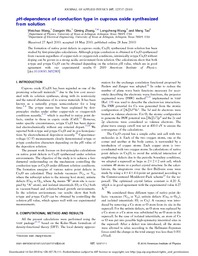
ATTENTION: The works hosted here are being migrated to a new repository that will consolidate resources, improve discoverability, and better show UTA's research impact on the global community. We will update authors as the migration progresses. Please see MavMatrix for more information.
Show simple item record
| dc.contributor.author | Tao, Meng | |
| dc.contributor.author | Wang, Longcheng | |
| dc.contributor.author | Zhang, Qiming | |
| dc.contributor.author | Wu, Dangxin | |
| dc.contributor.author | Wang, Weichao | |
| dc.date.accessioned | 2010-10-22T14:57:12Z | |
| dc.date.available | 2010-10-22T14:57:12Z | |
| dc.date.issued | 2010-06-28 | |
| dc.identifier.uri | http://hdl.handle.net/10106/5100 | |
| dc.description.abstract | The formation of native point defects in cuprous oxide, Cu2O, synthesized from solution has been studied by first-principles calculations. Although p-type conduction is obtained in Cu2O synthesized from vacuum regardless of copper-rich or oxygen-rich conditions, intrinsically n-type Cu2O without doping can be grown in a strong acidic environment from solution. Our calculations show that both n-type and p-type Cu2O can be obtained depending on the solution pH value, which are in good agreement with our experimental results. | en_US |
| dc.description.sponsorship | Supported by the U.S. Department of
Energy, Office of Basic Energy Sciences, and Division of Materials Sciences and Engineering under Award No. DESC0002062. | en_US |
| dc.language.iso | en_US | en_US |
| dc.publisher | AIP; | en_US |
| dc.subject | ab initio calculations | en_US |
| dc.subject | copper compounds | en_US |
| dc.subject | crystal growth from solution | en_US |
| dc.subject | pH | en_US |
| dc.subject | point defects | en_US |
| dc.title | pH-dependence of conduction type in cuprous oxide synthesized from solution | en_US |
| dc.type | Article | en_US |
| dc.publisher.department | Department of Physics, University of Texas at Arlington | en |
| dc.publisher.department | Department of Electrical Engineering, University of Texas at Arlington | en |
| dc.identifier.externalLink | https://www.uta.edu/ra/real/editprofile.php?pid=291&onlyview=1 | en_US |
| dc.identifier.externalLinkDescription | Link to Research Profiles | en_US |
Files in this item
- Name:
- JApplPhys_107_123717.pdf
- Size:
- 223.6Kb
- Format:
- PDF
- Description:
- PDF
This item appears in the following Collection(s)
Show simple item record


